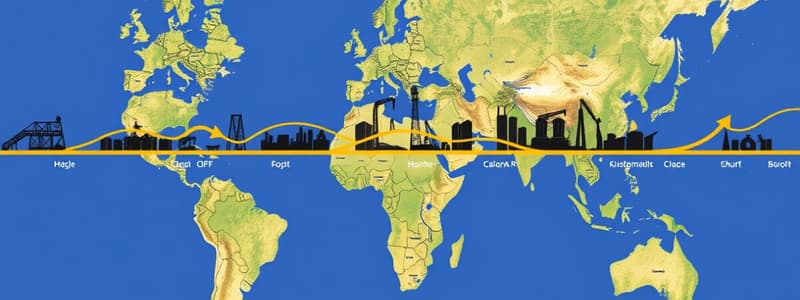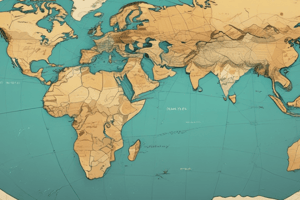Podcast
Questions and Answers
What is the main idea discussed in the reading?
What is the main idea discussed in the reading?
Pattern of Migration and its Causes
Which of the following are factors that caused migration during industrialization? (Select all that apply)
Which of the following are factors that caused migration during industrialization? (Select all that apply)
- Increased Travel Costs
- Technological Advancements (correct)
- Job Opportunities (correct)
- Economic Growth (correct)
People from Asia moved to America despite facing strong opposition.
People from Asia moved to America despite facing strong opposition.
False (B)
What are two push factors during political revolution?
What are two push factors during political revolution?
Match the following push factors with their corresponding pull factors:
Match the following push factors with their corresponding pull factors:
What advancements made international migration easier?
What advancements made international migration easier?
Modern migration patterns are predominantly from Europe to the Americas.
Modern migration patterns are predominantly from Europe to the Americas.
Flashcards are hidden until you start studying
Study Notes
Migration Patterns and Causes
- Migration during industrialization was driven by job opportunities, economic growth, technological advancements, and social changes.
- Key reasons for limited Asian migration to America included racism against immigrants and restrictive government laws, fueled by fears of job competition.
Influence of Industrialization on International Migration
- Economic opportunities arose as factories created jobs, attracting a labor class.
- Urbanization prompted city growth, necessitating a larger workforce to manage urban infrastructure.
- Political and social factors, like wars and religious persecution, forced people to seek safer living conditions.
- Technological advancements in transportation (e.g., railways and ships) facilitated easier and quicker international migration.
Push and Pull Factors During Political Revolution
- Push Factors:
- Political persecution led individuals to flee oppressive regimes.
- Instability and violence in home countries compelled migrations.
- Loss of property and livelihood triggered the need to relocate.
- Forced displacement from existing homes pushed many into migration.
- Pull Factors:
- Political freedom in new locations attracted individuals seeking better governance.
- Economic opportunities offered in destination countries incentivized migration.
- Safety and stability in new environments appealed to displaced populations.
- Supportive communities provided a network for newcomers.
Comparison Between Current and Past Migrations
- Economic reasons remain a consistent motivator for migration, with seekers pursuing better jobs and living conditions.
- Both past and current immigrants experienced discrimination and fear from local populations.
- Newcomers historically struggled to integrate into their new communities, a challenge still relevant today.
- Advances in technology have simplified migration processes and enhanced connectivity for modern migrants.
- Contemporary immigration laws are more complex and diversified compared to historical frameworks.
- Current migration patterns are global, encompassing flows from multiple regions, rather than predominantly from Europe to the Americas.
Studying That Suits You
Use AI to generate personalized quizzes and flashcards to suit your learning preferences.




